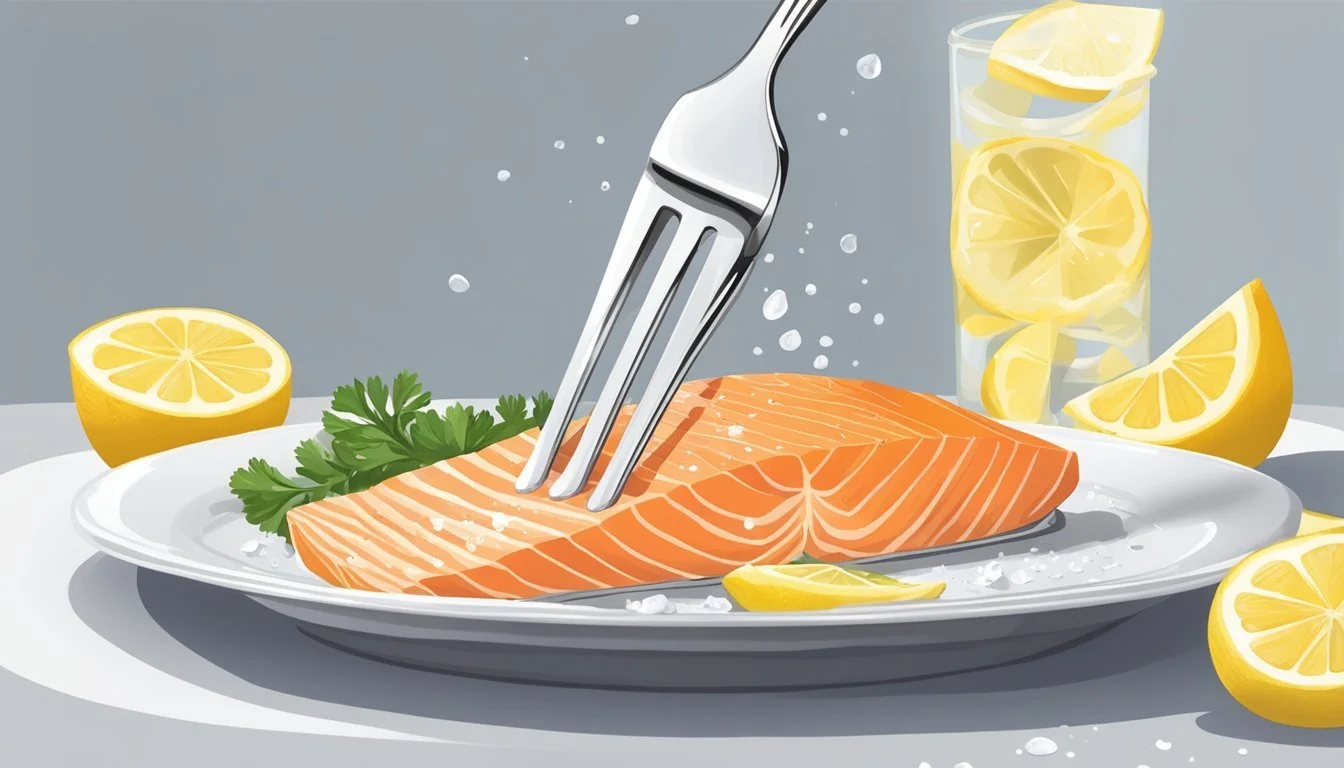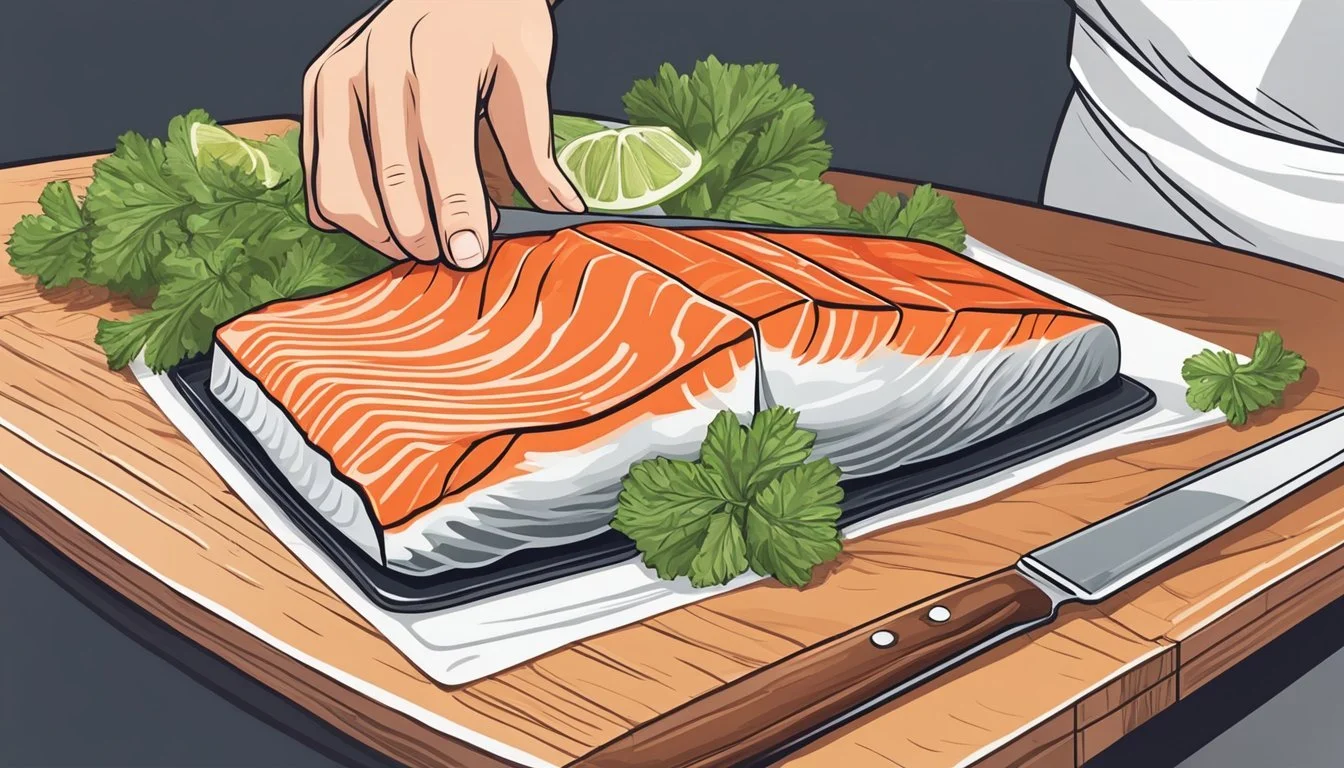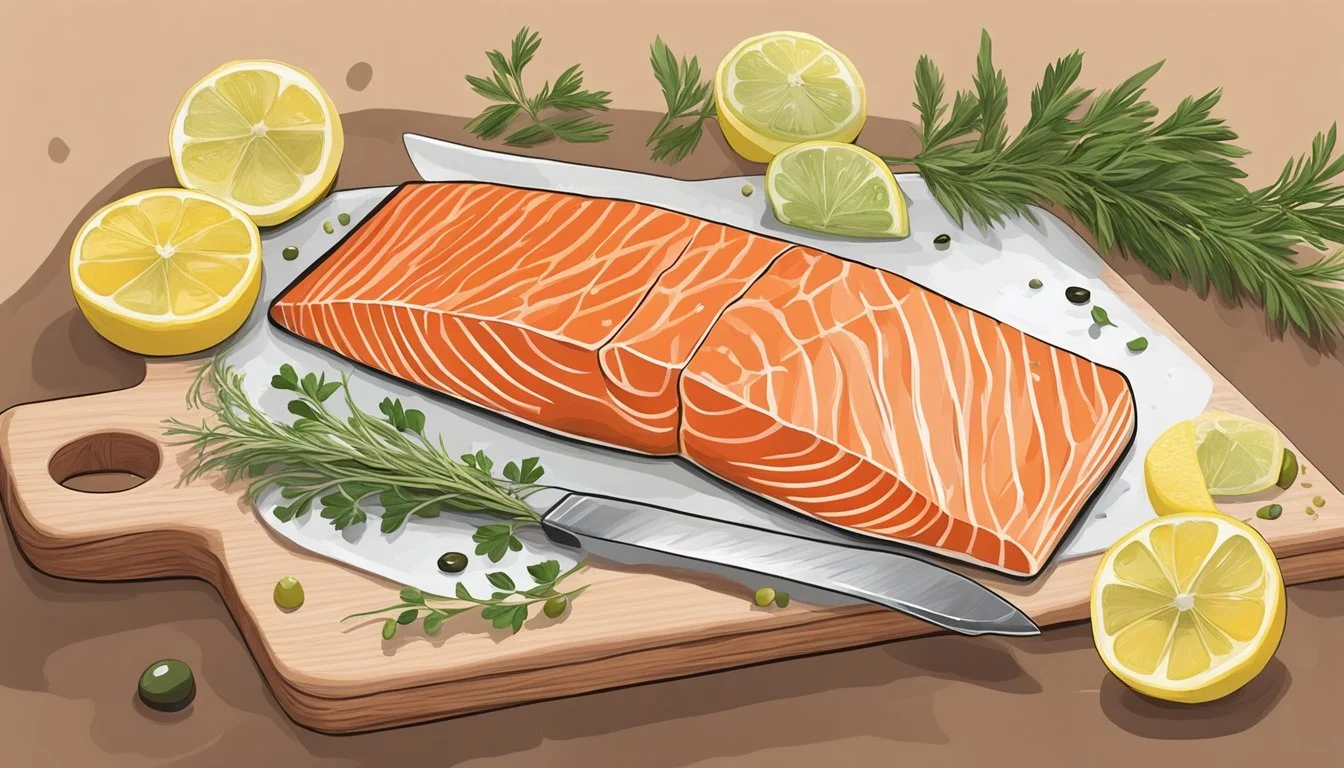How do you eat a salmon fillet?
Expert Tips for Enjoying This Seafood Delicacy
Eating a salmon (What wine goes well with salmon?) fillet properly can enhance the dining experience, showcasing the fish's delicate texture and rich flavor. Salmon, a versatile and widely enjoyed fish, is packed with omega-3 fatty acids, making it a healthy addition to any meal. When it comes to consuming salmon fillets, the method can vary depending on the preparation and personal preference.
A well-prepared salmon fillet can be enjoyed with minimal additions. The naturally flavorful fish pairs well with a simple seasoning of salt and pepper, allowing the taste of the salmon to take center stage. Cooked salmon should flake easily with a fork, indicating that it is done and ready to eat. For a balanced meal, salmon fillets are often served alongside vegetables or a salad and perhaps a portion of rice or potatoes.
The experience can also be elevated with the addition of complementary condiments and garnishes. A squeeze of fresh lemon juice or a drizzle of melted butter can bring out the richness of the salmon without overpowering its flavor. For those seeking a more robust flavor profile, herbs like dill (how long does dill last?) or a sprinkle of capers (What wine goes well with capers?) can add a refreshing twist. Diners can easily adapt the accompaniments to suit their taste, making salmon fillets a versatile choice for any occasion.
Selecting Quality Salmon
When choosing a salmon fillet, it’s essential to consider its freshness and nutritional value. Selecting the right type of salmon based on these criteria ensures a high-quality and healthy meal.
Identifying Fresh Salmon
Freshness is paramount when purchasing salmon. Signs of a fresh salmon fillet include bright, translucent flesh and a clean, oceanic smell. The flesh should be firm to the touch and bounce back when lightly pressed. Avoid fillets with a dull color or mushy texture, which indicate it may be past its best. The gills should be red, and the eyes clear and bright if buying a whole fish. When possible, sourcing salmon directly from a reputable fishmonger or trusted supermarket aids in obtaining the freshest fish.
Salmon Varieties and Nutritional Info
Salmon comes in several varieties, each with unique flavors and nutritional profiles:
King Salmon: Also known as Chinook, this variety is the largest and boasts high-fat content, leading to a rich, buttery texture. It is an excellent source of omega-3 fatty acids.
Sockeye Salmon: Noted for its deep red flesh and robust flavor, sockeye is a nutrient-rich choice with a good balance of protein, vitamins, and minerals.
Coho Salmon: Coho or silver salmon has a milder taste and lighter color. It provides a lower fat content compared to King and Sockeye but is still a valuable source of protein and omega-3s.
Nutritional Information per 3.5 oz (100 g) serving:
Type Calories Protein Omega-3 Fatty Acids Cholesterol Potassium Sodium King Salmon 231 25.7 g 1.7 g 85 mg 363 mg 60 mg Sockeye Salmon 216 27.3 g 1.1 g 87 mg 534 mg 59 mg Coho Salmon 178 24.2 g 1.0 g 67 mg 383 mg 52 mg
Wild salmon typically offer superior nutritional benefits compared to farmed varieties, including higher levels of omega-3 fatty acids and lower risk of containing contaminants. Consumers looking for the healthiest option should consider wild-caught salmon.
Essential Preparations
When preparing a salmon fillet for cooking, it is crucial to focus on a few preliminary steps to ensure the best possible flavor and texture. These include bringing the fillet to the right temperature, seasoning it correctly, and choosing the best cooking fat to complement its rich flavor.
Bringing Salmon to Room Temperature
Before cooking, the salmon fillets should be taken out of the refrigerator to reach room temperature, about 15 to 20 minutes. This step allows for even cooking, preventing the outside from overcooking while the inside reaches the desired doneness.
Seasoning the Salmon
A proper seasoning enhances the natural flavors of the salmon. Start by patting the fillets dry with paper towels. Sprinkle with kosher salt and freshly ground black pepper to taste. For added flavor, one can incorporate herbs like dill, or a squeeze of lemon juice. Here's a basic seasoning guideline:
Kosher salt: 1/2 teaspoon per fillet
Black pepper: 1/4 teaspoon per fillet
Dill: 1 tablespoon of chopped fresh dill (optional)
Lemon: a few squeezes per fillet (optional)
Selection of Cooking Fat
The choice of cooking fat can make a significant difference in flavor. For searing, extra-virgin olive oil or butter are excellent choices, as they can enhance the fillet's taste with their own notes. Olive oil is preferred for its higher smoke point and subtle flavor, while butter offers a rich, creamy taste.
Olive oil: 1-2 tablespoons, depending on the number of fillets
Butter: use sparingly, as it can burn quickly
By following these essential preparations, one sets the stage for a perfectly cooked salmon fillet that is packed with flavor and cooked to the ideal texture.
Cooking Methods Overview
The versatility of salmon fillets allows for a variety of cooking methods, each imparting distinct flavors and textures. By tailoring the temperature, cookware, and technique, one can achieve a perfectly cooked salmon fillet, whether opting for baking, grilling, pan-searing, poaching, or roasting.
Baking Salmon
Baking is a fuss-free method that involves cooking salmon evenly at a moderate temperature. For baked salmon, preheat the oven to 425 degrees Fahrenheit and prepare a baking sheet with parchment paper or aluminum foil. A salmon fillet typically requires 12-15 minutes in the oven, ensuring a moist and flaky texture when done correctly.
Grilling Salmon
Grilled salmon (What wine goes well with grilled salmon?) is renowned for its smoky flavor and appealing grill marks. Preheat the grill to a medium-high temperature before placing the salmon directly on the grates or on a sheet of foil, skin-side down. The fillet usually cooks through in about 6-10 minutes, with the lid closed to trap heat.
Pan-Searing Salmon
Pan-searing on a stovetop provides a crisp exterior and tender interior. Use a heavy iron or nonstick skillet on high heat and add a dash of extra-virgin olive oil. Place the salmon skin-side down and cook for 3-4 minutes per side, depending on thickness, to achieve a golden-brown crust.
Poaching Salmon
Poaching salmon involves gently cooking the fillet in a liquid such as vinegar, broth, or water infused with aromatics, providing a delicate texture. The poaching temperature should be just below simmering, ensuring the salmon stays tender.
Roasting Salmon
To roast salmon, start by preheating the oven to 400 degrees Fahrenheit. Create individual packets using parchment paper (salmon en papillote) or place the salmon on a sheet pan. Cook for approximately 12-15 minutes, depending on the oven and the thickness of the fillets, for evenly oven-roasted salmon.
Cooking Techniques and Tips
When preparing a salmon fillet, mastering the cooking technique ensures that the fish retains its tenderness and natural flavors. Cooking temperature and time are critical factors, and incorporating aromatics and marinades can enhance the culinary experience.
Determining Doneness
To assess whether a salmon fillet is cooked to the desired level, one should measure its internal temperature with a thermometer. A fillet is typically done when it reaches an internal temperature of 145°F, evidenced by a change from translucent to opaque and the ability to flake easily with a fork. However, some prefer their salmon less cooked, aiming for a temperature near 125°F for a slightly rarer finish.
Avoiding Overcooking
Salmon is known for its tender, flaky texture, which can be lost if overcooked. A key technique is to resist the urge to keep cooking; remember that salmon will continue cooking from residual heat even after it's removed from the source. Thus, it is prudent to remove the salmon from the heat a few minutes before it reaches the desired doneness.
Achieving Perfect Skin Texture
For pan-seared salmon with crispy skin, use a nonstick pan and high heat. Start with the skin-side down and cook until the skin releases easily from the pan, typically 5-6 minutes. Flip the fillet and finish cooking on the other side to achieve a melt-in-your-mouth texture. This approach demands attention and care to not burn the skin or overcook the flesh.
Using Aromatics and Marinades
Marinades and aromatics can elevate the flavor of salmon. A simple combination of honey, garlic, soy sauce, and lemon juice can create a marinade that infuses the fish with a sweet and savory taste. Peppercorns and other herbs added to the pan during searing introduce subtle flavors. Such additions should complement, not overpower, the natural taste of the salmon.
Finishing and Serving
Proper finishing and serving techniques can transform a simple salmon fillet into a gourmet meal. Attention to rest times, complementary sides, and presentation are essential for the best eating experience.
Resting the Salmon Before Serving
Once the salmon fillets are cooked to the desired doneness, they should be allowed to rest, undisturbed, for a few minutes. Resting enables the juices to redistribute throughout the fish, resulting in moist and flavorful bites. It is recommended to let the salmon sit for about 3-5 minutes before serving.
Pairing with Sides and Sauces
Salmon's versatile flavor pairs beautifully with a variety of sides and sauces. Consider these options to enhance your dish:
Sides:
Asparagus
Quinoa
Roasted vegetables
Garlic mashed potatoes
Sauces:
Lemon butter sauce: Mix melted butter with fresh lemon juice, and a touch of garlic.
Dill sauce: Combine mayonnaise, chopped fresh dill, lemon juice, and garlic.
Classic hollandaise: Whisk together egg yolks, lemon juice, and melted butter over heat until thickened.
Bold and bright flavors like lemon and dill not only complement the taste but also add freshness to the palatte.
Plating for Restaurant Quality Presentation
For a restaurant quality presentation, one should plate the salmon with both aesthetics and function in mind. Here's a simple guide:
Use a fish spatula to gently lift the salmon fillet from the cooking surface to avoid breaking.
Place the salmon on a paper towel for a brief moment to absorb any excess oil.
Transfer the salmon onto a warm plate, skin-side down.
Garnish with a sprig of parsley or dill and a wedge of lemon for a fresh, appealing look.
Following these steps helps ensure that each component of the plate highlights the beautiful, cooked salmon fillet, creating an impressive dish ready to be enjoyed.
Understanding Salmon Safety
Ensuring the safety of salmon fillets one consumes involves careful attention to cooking temperatures and storage methods. Proper handling of both fresh and frozen salmon is imperative to maintain quality and minimize the risk of foodborne illnesses.
Safe Internal Cooking Temperatures
When cooking salmon, achieving the right internal temperature is crucial for safety and quality. One should cook salmon to an internal temperature of at least 145 degrees Fahrenheit (62.8 degrees Celsius), as recommended by the Food Safety and Inspection Service (FSIS). To accurately determine if this temperature has been reached, it is advisable to use a food thermometer inserted into the thickest part of the salmon fillet.
The following table outlines the different cooking methods and the respective temperatures salmon should reach:
Cooking Method Temperature Oven 145°F Grill 145°F Pan-frying 145°F
Proper Storage Techniques
Proper storage of salmon, whether fresh or frozen, is essential to ensure it remains safe to eat. Fresh salmon should be stored in the refrigerator at a temperature of 32–34 degrees Fahrenheit (0–1 degree Celsius) and consumed within 1–2 days. If the salmon is not to be used within this timeframe, freezing is an effective way to prolong shelf-life while maintaining safety. Store frozen salmon in the freezer at 0 degrees Fahrenheit (-18 degrees Celsius) or below. Prior to cooking, frozen salmon should be safely thawed by transferring it to the refrigerator or using cold water; it must not be left at room temperature.
Frequently Asked Questions
When preparing salmon fillets, cooks must consider factors such as the salmon's origin, the cookware used, and the fillet's thickness, as well as the use of fresh ingredients versus alternatives. Addressing these topics ensures a pleasurable and successful cooking experience.
Comparing Wild vs. Farmed Salmon
Wild salmon is often prized for its vibrant color and rich flavor, which are results of its natural diet. Farmed salmon, while more consistent in size and price, may contain different levels of nutrients and have a milder taste. Those who prefer a less intense flavor or a more budget-friendly option might opt for farmed salmon.
Choosing the Right Cooking Equipment
The choice of cooking equipment profoundly impacts the texture and flavor of the salmon fillet. For a crispy skin, a nonstick skillet is ideal. When baking, using a pan lined with parchment paper in the oven can promote even cooking, while a foil-wrapped salmon retains moisture.
Cooking Thinner Fillets Effectively
Thinner fillets require a careful approach to avoid overcooking. The key lies in a shorter cooking time and lower temperatures. In an oven preheated to 400°F, thin, skinless fillets may only need about 10-12 minutes. For pan-searing, they should be cooked on medium-high heat for just a couple of minutes on each side.
Substituting Fresh Ingredients
The freshness of ingredients such as salmon, herbs like dill, or vegetables will enhance the dish's overall flavor profile. However, if someone doesn't have access to fresh salmon, using frozen fillets is an acceptable substitute. They should be thoroughly defrosted and patted dry before cooking. When fresh dill is unavailable, dried dill can be used, but it's important to adjust the quantity as dried herbs are more potent.
Conclusion
Consuming salmon fillets offers a delightful culinary experience that can be enhanced through various cooking techniques. Careful preparation ensures the fish retains its rich flavor and health benefits. Individuals can follow several trusted recipes for desired outcomes, such as baking, grilling, or pan-searing. When baking, they generally preheat the oven to 400°F and season the salmon before cooking.
For a well-rounded meal, they might complement the salmon with a side of vegetables or a fresh salad. The versatility of salmon allows for it to be incorporated into numerous dietary preferences, aligning with a wide range of taste profiles. Those grilling salmon commonly aim for a smoky flavor, attentively monitoring the cooking to prevent sticking or overcooking.
Regardless of the cooking method chosen, the key lies in the salmon’s internal temperature, which should reach 145°F to ensure safety and optimal taste. In essence, salmon fillets present a nutritious, adaptable, and enjoyable dining option suitable for both weeknight dinners and special occasions. They encourage home cooks to explore an array of flavorful recipes and find the cooking style that suits their preference.








